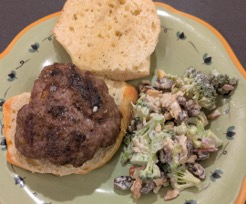Carolyn McDonald Graf
In Broths To Bannocks, Catherine Brown, a well-known food writer and author, traces the history of Scottish cooking from 1690 to 1990. Along the way, she weaves what people ate with historical events. During the 1600s, the chieftains were self-sufficient on their lands and looked after their people. As time moved on, outside influences changed their way of life, as well as their way of eating.
She writes that after 1715, “What the Highlands need is capital investment and professional advice on how to work out more efficient forms of agriculture to feed the growing population. What they have is a ruling class lacking the necessary financial resources, many deprived of their lands and sometimes totally destitute. It is a recipe for disaster which reflects on the Highland table in the years to come.”
Scots leaving the Highlands and filling the cities lived in crowded tenements. They could no longer afford the oat porridge and cream but ate white bread and drank tea. Those that could afford the pubs and taverns tasted new foods coming from places far away. France was the center of fashionable food, and the wealthy hired chefs and cooks to make this food for them. Some Scots, like Robert Burns, feared the Scottish way of life was dying out. His poem to the Great Chieftain o’ the Pudding Race glorified one of the most basic and ordinary foods: haggis. It is assumed that he chose haggis over other humble dishes, as it would symbolize honest peasant food, the thrift and ingenuity of the Scots and be a snub to those who were entranced by French foods.
Fifty years later, the tug between the English and Scottish continued. Sir Walter Scott was also passionate about preserving the old traditional ways and food and wrote his stories romanticizing the Highlanders. There was another writer who was also paying close attention to the national palate and national dishes. Christian Isobel Johnstone wrote The Cook and Housewife’s Manual under the name ‘Meg Dobs’. The name came from one of Scott’s novels, St. Ronan’s Well. The cookbook was a hit and went into at least sixteen editions.
The 1840’s saw the worst of the Highland Clearances, where chieftains went bankrupt and many crofters were turned off their land to make room for large sheep farms. Those that stayed were reduced to a diet of potatoes, some milk, and oatmeal if they were lucky. Why did those stay? How could the Highlanders put tradition above the wealth they might get for their land? Wealth did not mean anything for those who had never had money. Their wealth came from their fields and the sea. When they lost their access to these, they had no understanding of any other life. Travelers to the area found not the romance of the books they had read and the paintings they had seen, but a poor and bedraggled people. Because the tourists spoke no Gaelic, they did not understand the feelings of the Highlanders and thought them dirty and lazy.
Today, in spite of the influx of people and ideas from England and beyond, the resilient Scots still have a strong sense of nationality and have maintained many of the traditional foods and recipes, evidenced in the many cookbooks available today.
Saucermeat Bronies
It is said that saucermeat, a mixture of chopped meat and spices, originated as a way of preserving meat before the advent of refrigeration. This seems unlikely, as the cost of the spices far outweigh that of the meat. What it does show is the frugality and ingenuity of the Shetland Islanders who took the less flavorful cuts of meat and made a tasty dish with it.
The original recipe:
A mixture of spices in the following proportions is first made.
Quarter of an ounce of Allspice
Quarter of an ounce of Cloves
Quarter of an ounce of Ginger
Quarter of an ounce of White Pepper
Quarter of an ounce of Black Pepper
Eighth of an ounce of Mace
Eighth of an ounce of Jamaica Pepper
Eighth of an ounce of Cinnamon
This along with 6 ounces of salt will season 12 pounds of meat.
For the Bronies:
One pound of saucermeat
One pound of minced steak
One tea cup of Breadcrumbs
One tablespoon of Chopped Onion
Pepper and Salt
One Egg or Milk to moisten
Mix all together thoroughly with hands in a basin form into cakes about ¾ inch thick; fry on both sides in smoking hot fat; reduce heat and allow to cook through more slowly for 10-15 minutes; drain and serve hot.
Broths to Bannocks Cooking in Scotland 1690 to the present day, Catherine Brown, John Murray Publishers, London 1990.
Here’s how I adapted this recipe:

Ingredients:
One pound Ground Beef
1/8 teaspoon Allspice
1/8 teaspoon Cloves
1/8 teaspoon Ginger
1/4 teaspoon Black Pepper
1 pinch of Mace
1 pinch of Cinnamon
1/2 cup Bread Crumbs
1/4 cup Milk
Mix all together thoroughly and shape into thick patties. Cook on a grill or in a frying pan. Modern versions of this recipe serve it on a roll. I found that these patties cooked more slowly on a grill than beef hamburgers, which might explain their directions to lower the heat and allow the bronies to cook for such a long time.

